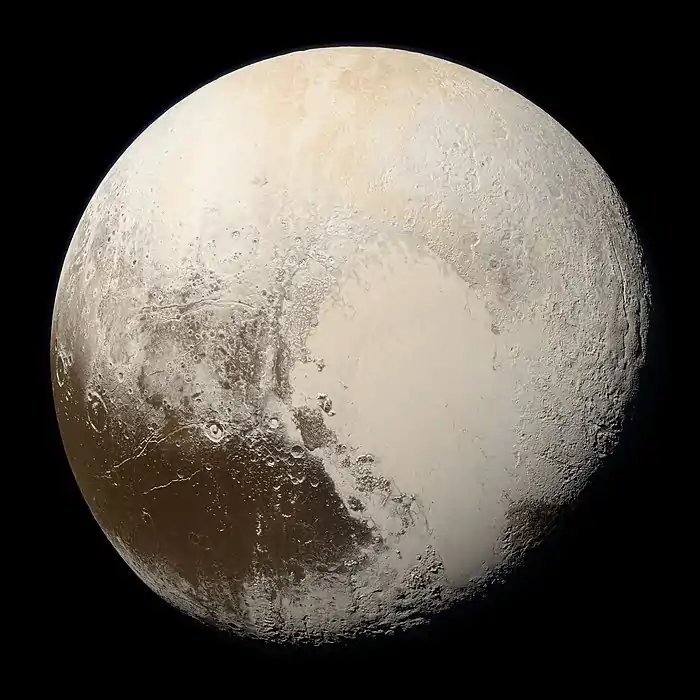(120348) 2004 TY364
(120348) 2004 TY364, provisionally known as 2004 TY364, is a trans-Neptunian object. It is an inner classical Kuiper belt object in the definition by Gladman, Marsden, and Van Laerhoven (e<0.24).[2] Its inclination of almost 25 degrees disqualifies it as such in Marc Buie's definition.[3] It is also not listed as a scattered disc object by the Minor Planet Center.[8] It was discovered by Michael E. Brown, Chad Trujillo and David L. Rabinowitz on October 3, 2004 at the Palomar Observatory.
| Discovery | |
|---|---|
| Discovered by | M. E. Brown C. Trujillo D. L. Rabinowitz |
| Discovery site | Palomar Obs. |
| Discovery date | 3 October 2004 |
| Designations | |
| (120348) 2004 TY364 | |
| TNO [1] · cubewano[2] SCATEXTD[3] Other[4] | |
| Orbital characteristics[1] | |
| Epoch 13 January 2016 (JD 2457400.5) | |
| Uncertainty parameter 3 | |
| Observation arc | 11834 days (32.40 yr) |
| Earliest precovery date | 16 July 1983 |
| Aphelion | 41.384 AU (6.1910 Tm) |
| Perihelion | 36.176 AU (5.4119 Tm) |
| 38.780 AU (5.8014 Tm) | |
| Eccentricity | 0.067140 |
| 241.50 yr (88208.5 d) | |
| 265.93° | |
| 0° 0m 14.692s / day | |
| Inclination | 24.8499° |
| 140.6141° | |
| ≈ 12 May 2079[5] ±6 days | |
| 359.71° | |
| Earth MOID | 35.1896 AU (5.26429 Tm) |
| Jupiter MOID | 30.8216 AU (4.61085 Tm) |
| Physical characteristics | |
| Dimensions | 512+37 −40 km[6] |
| 11.70 h (0.488 d)[1] | |
| 0.107+0.020 −0.015[6] | |
| 20.4[7] | |
| 4.520±0.070,[6] 4.8[1] | |
With an absolute magnitude of 4.5, it is likely a dwarf planet.[9] However, light-curve analysis has questioned whether it really is one.[10]
References
- "JPL Small-Body Database Browser: 120348 (2004 TY364)" (2005-09-01 last obs; arc: 22.13 years). Retrieved 7 April 2016.
- Nomenclature in the outer Solar System
- Marc W. Buie. "Orbit Fit and Astrometric record for 120348" (last observation: 2005-08-31 using 20 of 21 observations over 22 years). SwRI (Space Science Department). Retrieved 2014-11-13.
- "MPEC 2010-S44 :Distant Minor Planets (2010 OCT. 11.0 TT)". IAU Minor Planet Center. 2010-09-25. Retrieved 2014-11-16.
- JPL Horizons Observer Location: @sun (Perihelion occurs when deldot changes from negative to positive. Uncertainty in time of perihelion is 3-sigma.)
- Lellouch, E.; Santos-Sanz, P.; Lacerda, P.; Mommert, M.; Duffard, R.; Ortiz, J. L.; Müller, T. G.; Fornasier, S.; Stansberry, J.; Kiss, Cs.; Vilenius, E.; Mueller, M.; Peixinho, N.; Moreno, R.; Groussin, O.; Delsanti, A.; Harris, A. W. (September 2013). ""TNOs are Cool": A survey of the trans-Neptunian region. IX. Thermal properties of Kuiper belt objects and Centaurs from combined Herschel and Spitzer observations" (PDF). Astronomy & Astrophysics. 557: A60. arXiv:1202.3657. Bibcode:2013A&A...557A..60L. doi:10.1051/0004-6361/201322047. Retrieved 7 November 2014.
- "AstDys (120348) 2004TY364 Ephemerides". Department of Mathematics, University of Pisa, Italy. Retrieved 2009-12-10.
- "List Of Centaurs and Scattered-Disk Objects". Minor Planet Center. Retrieved 2014-11-13.
- Michael E. Brown. "How many dwarf planets are there in the outer solar system? (updates daily)". California Institute of Technology. Archived from the original on 2011-10-18. Retrieved 2011-08-25.
- Gonzalo Tancredi & Sofía Favre (13 October 2008). "Dwarf Planet & Plutoid Headquarters". Portal Uruguayo de Astronomía. Retrieved 2010-09-22. (Which are the dwarfs in the Solar System?)
This article is issued from Wikipedia. The text is licensed under Creative Commons - Attribution - Sharealike. Additional terms may apply for the media files.
_(cropped).jpg.webp)
